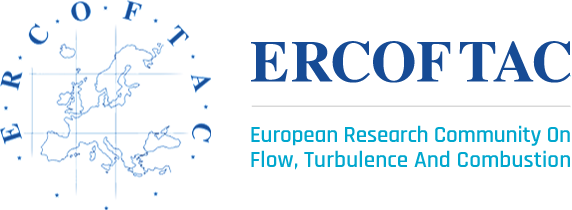ERCOFTAC PC Netherlands
Hearing The Invisible from Particle Kinetics to Vortex Dynamics
Authors: Emanuele Sticchi, Kaj Hoefnagel, Anastasia Marketou
(PhD Candidates, Delft University of Technology, Faculty of Aerospace Engineering, Aeroacoustics group, The Netherlands)
Daniele Ragni
(Associate Professor, Delft University of Technology, Faculty of Aerospace Engineering, Aeroacoustics group, The Netherlands)
From fundamental physics to full-scale performance study: visualization of particles artistically illustrates how the kinetic principles of the lattice Boltzmann theory model reality. A seamless evolution into high-fidelity results of LBM-CFD simulations of a full aircraft showcases the power of physical modelling in the study of aerodynamic sources of noise. First, the dilatation field reveals how sound sources from the propeller blades determine audible interfering sound waves in the surrounding field. Iso-surfaces of 𝜆2 finally highlight the complex interplay of the propeller wake and the strut-braced wing. A journey from microscopic interactions to macroscopic complexity, where theory takes flight.
Related Publications:
1. Sticchi E., Ragni, D., Casalino D., and Avallone F. "Aerodynamic Noise Prediction of Strut-Braced Wing Aircraft," AIAA 2024-3012. 30th AIAA/CEAS Aeroacoustics Conference (2024). June 2024.
Scientific Abstract:
In companies all around the world, engineers are designing innovative new products that greatly benefit humanity. In the past, these engineers tested their designs by building physical prototypes, but today, much of this testing is done using computer simulations. One widely used class of simulations focuses on modelling fluid flow, which is particularly relevant in aerospace applications. A powerful approach for simulating fluid flow is the lattice-Boltzmann method (LBM), which has proven effective for various applications, including multi-phase flows and aeroacoustics. Because of its accuracy and efficiency, LBM has become a valuable tool in the design and analysis of advanced aerospace technologies. One such application is the study of aerodynamic installation effects on propeller-driven, strut-braced wings—a key aspect of next-generation aircraft design. This research is part of a broader PhD study within the European project HERWINGT, which aims to develop a disruptive wing concept for future aircraft. By leveraging the capabilities of LBM, this study seeks to gain deeper insights into the complex aerodynamic interactions in these novel wing configurations, contributing to the advancement of more efficient and sustainable aviation technologies. Through simulations of different aircraft configurations, this study provided key insights into the aerodynamic and aeroacoustic interaction between the propeller slipstream and the strut-braced wing. The results revealed that the strut experiences a distinct wake-wing interaction mechanism, leading to different surface pressure fluctuations compared to the main wing. From an aeroacoustic perspective, the propeller’s slipstream significantly influences both the aerodynamic efficiency and noise footprint, with propeller rotation direction playing a crucial role in noise emissions. Notably, an outboard-up rotation was shown to reduce far-field noise but increased pressure fluctuations on the fuselage, highlighting a trade-off between noise reduction and structural considerations. These findings contribute to a deeper understanding of installation effects in future propeller-driven aircraft and provide valuable insights for optimizing aerodynamic performance and noise mitigation strategies. The results highlight the power of the Lattice Boltzmann Method in capturing complex aerodynamic and aeroacoustic interactions with remarkable detail. The ability to go from particle-based simulations to full-scale CFD of an entire aircraft demonstrates not only the method’s versatility but also its potential to revolutionize future aircraft design. By bridging fundamental physics with real-world applications, this approach paves the way for more efficient, quieter, and sustainable aviation.
